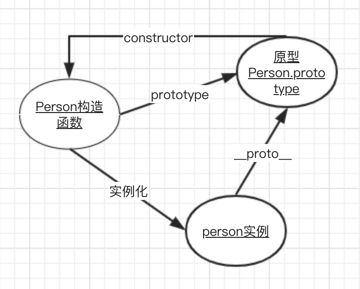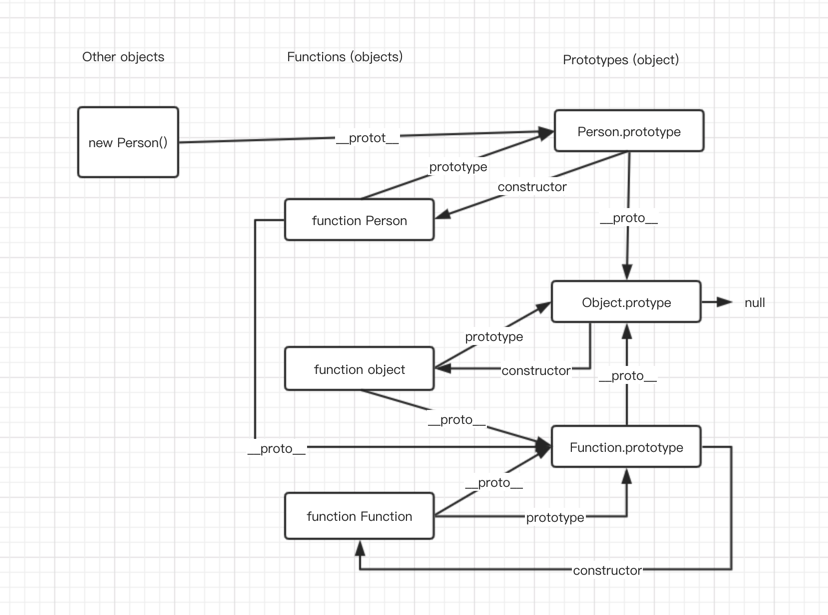javascript中的继承
继承
继承是面向软件技术当中的一个概念。如果一个类别B“继承自”另一个类别A,就把这个B称为“A的子类”,而把A称为“B的父类”也可以称“A是B的超类”。继承可以使得子类具有父类别的各种属性和方法,而不需要再次编写相同的代码。在令子类别继承父类别的同时,可以重新定义某些属性,并重写某些方法,即覆盖父类别的原有属性和方法,使其获得与父类别不同的功能。另外,为子类追加新的属性和方法也是常见的做法。(引用 维基百科)
通俗一点的讲: 就是我自己没有,但是别人有,那我拿过来成为自己的, 是实现复用的一种手段。
JavaScript中的继承和其他语言(例如c++、Java)的继承不太一样, JavaScript采用的是原型继承,那原型又是什么呢
原型
提到原型,脑子里就会浮现一幅这样的图。

对应代码如下
// Person 构造函数
function Person() {}
// person 实例对象
let person = new Person()
我们假设原型对象为Prototype, 则满足
Person.prototype === Prototype // true
person.__proto__ === Prototype // true
Prototype.constructor === Person // true
你可以把原型对象想象成一个公共区域,放在里面的任何属性和方法都是被实例所共享的
JavaScript继承实现
基本概念介绍完了,那我们开始进入正题,来讨论讨论JavaScript中继承的实现
1. 原型链继承
基本思想: 让子类的原型对象指针指向父类的实例
代码如下:
// 父类
function Person(name) {
this.name = name
this.friends = []
}
Person.prototype.sayHello = function () {
console.log(`${this.name} say hello`)
}
// 子类
function Student(studentId) {
this.studentId = studentId
}
// Student 继承 Person
Student.prototype = new Person('simple')
let student = new Student('001')
student.sayHello() // simple say hello
let student2 = new Student('002')
student.friends.push('002')
student2.friends.push('001')
console.log('student.name', student.name) // simple
console.log('student2.name', student2.name) // simple
console.log('student.friends', student.friends) // ['001', '002']
console.log('student2.friends', student2.friends) // ['001', '002']
从如上代码的执行结果可以看出, Student继承了Person的name属性和sayHello方法, 实现了基本的继承,但是会发现有如下几个问题
-
就拿
name属性来说,Student虽然继承了name属性,但是name属性是放在原型上的,也就是说所有的Student实例都会共享这个属性,这显然是不合理的, 有的人可能会这么做student1.name = 'simple_h' student2.name = 'student_sl' console.log('student.name', student.name) // simple_h console.log('student2.name', student2.name) // simple_sl我重新赋值,这不是也能合理输出嘛, 究其原理,只不过是在实例对象上新增了
name属性,导致在获取这个name属性的时候不用再去原型上查找罢了,如果这么做,那原型上的name属性就好像是多余的了🤦♂️-
以
friends属性为例,因为friends属性是引用对象,又因为所有实例对象共享这个属性,所以当某个实例修改该实例对象时, 会影响到所有实例对象 -
在创建子类时,不能向父类型的构造函数中传递参数
-
子类原型对象的
constructor不能正确的指向构造函数 或者说 子类原型对象没有constructor
-
2.借用构造函数
基本思想:在子类的构造函数内执行父类的构造函数
代码如下:
// 父类
function Person(name) {
this.name = name
this.friends = []
}
Person.prototype.sayHello = function () {
console.log(`${this.name} say hello`)
}
// 子类
function Student(name, studentId) {
Person.call(this, name) // 继承父类
this.studentId = studentId
}
let student = new Student('simple_h', '001')
student.sayHello() // Uncaught TypeError: student.sayHello is not a function
let student2 = new Student('simple_sl', '002')
student.friends.push('002')
student2.friends.push('001')
console.log('student.name', student.name) // simple_h
console.log('student2.name', student2.name) // simple_sl
console.log('student.friends', student.friends) // ['002']
console.log('student2.friends', student2.friends) // ['001']
从上面代码的执行结果来看,好像正好弥补的原型链继承的缺点,但是好像也有问题
-
不能继承父类原型中的方法,导致子类调用
sayHello方法报错 -
函数都在构造函数中定义,因此复用就无从谈起了

-.-

既然借用构造函数继承可以弥补原型链继承的缺点,那我们把两者结合起来试试呀
3. 组合继承
基本思想: 将原型链和借用构造函数继承的技术组合到一块,发挥二者之长。使用原型链实现对原型属性和方法的继承,通过构造函数实现对实例属性的继承
代码如下:
// 父类
function Person(name) {
this.name = name
this.friends = []
}
Person.prototype.sayHello = function () {
console.log(`${this.name} say hello`)
}
// 子类
function Student(name, studentId) {
Person.call(this, name) // 继承父类属性
this.studentId = studentId
}
Student.prototype = new Person()
Student.prototype.constructor = Student
// 实例化
let student = new Student('simple_h', '001')
student.sayHello() // simple_h say hello
let student2 = new Student('simple_sl', '002')
student.friends.push('002')
student2.friends.push('001')
console.log('student.name', student.name) // simple_h
console.log('student2.name', student2.name) // simple_sl
console.log('student.friends', student.friends) // ['002']
console.log('student2.friends', student2.friends) // ['001']
组合继承避免了原型链继承和借用构造函数的缺陷,融合了他们的优点,成为JavaScript中最常用的继承模式。但是,这么写真的没有问题吗?你难道不觉得Student原型对象中的name和friends属性是多余的吗?调用两次父类构造函数不也是多余的吗?
4.原型式继承
基本思想:借助原型可以基于已有的对象创建新对象,同时还不必因此创建自定义类型
代码如下:
function object(o) {
function F() {}
F.prototype = o
return new F()
}
let person = {
name: 'simple',
friends: ['xiaoming', 'xiaohong']
}
let anotherPerson = object(person)
anotherPerson.name = 'zhangsan'
anotherPerson.friends.push('wangwu')
let yetAnotherPerson = object(person)
yetAnotherPerson.name = 'lisi'
yetAnotherPerson.friends.push('zhaoliu')
console.log(person.friends) // ["xiaoming", "xiaohong", "wangwu", "zhaoliu"]
这种原型继承要求你必须有一个对象可以作为另一个对象的基础, 如果有这么一个对象的话,可以把它传递给object()函数,然后再根据具体需求对得到的对象加以修饰即可。在这个例子中,anotherPerson和yetAnotherPerson的原型都是person, 而person中的friends属性是引用类型,这说明friends属性不仅仅归person所有,而是会被anotherPerson和yetAnotherPerson所共有,所以最后console的输出才是这样的。
ES5通过Object.create()方法规范了原型继承,这个方法接收两个参数: 一个用作新对象原型的对象和(可选的)一个为新对象定义额外属性的对象。
let person = {
name: 'simple',
friends: ['xiaoming', 'xiaohong']
}
let anotherPerson = Object.create(person)
anotherPerson.name = 'zhangsan'
anotherPerson.friends.push('wangwu')
let yetAnotherPerson = Object.create(person)
yetAnotherPerson.name = 'lisi'
yetAnotherPerson.friends.push('zhaoliu')
console.log(person.friends) // ["xiaoming", "xiaohong", "wangwu", "zhaoliu"]
在没有必要兴师动众的创建构造函数,而只想让一个对象与另一个对象保持类似的情况下,原型式继承是完全可以胜任的。
5.寄生式继承
基本思想: 创建一个仅用于封装继承过程的函数,该函数在内部以某种方式来增强对象,最后再像真的是它做了所有工作一样返回对象
代码如下:
function createAnother(original) {
var clone = object(original)
clone.sayHi = function () {
console.log('hi')
}
return clone
}
let person = {
name: 'simple',
friends: ['xiaoming', 'xiaohong']
}
let anotherPerson = createAnother(person)
anotherPerson.sayHi() // hi
在主要考虑对象而不是自定义类型和构造函数的情况下,寄生式继承也是一种有用的模式。
使用寄生式继承为对象添加函数,会由于不能做到函数复用而降低效率
6.寄生组合式继承
基本思想: 通过借用构造函数来继承属性,通过原型链的混成形式来继承方法, 不必为了指定子类的原型而调用父类的构造函数。
代码如下:
function object(o) {
function F() {}
F.prototype = o
return new F()
}
function inheritPrototype(subType, superType) {
let prototype = object(superType.prototype)
prototype.constructor = subType
subType.prototype = prototype
}
// 父类
function Person(name) {
this.name = name
this.friends = []
}
Person.prototype.sayHello = function () {
console.log(`${this.name} say hello`)
}
// 子类
function Student(name, studentId) {
Person.call(this, name) // 继承父类属性
this.studentId = studentId
}
inheritPrototype(Student, Person)
// 实例化
let student = new Student('simple_h', '001')
student.sayHello() // simple_h say hello
let student2 = new Student('simple_sl', '002')
student.friends.push('002')
student2.friends.push('001')
console.log('student.name', student.name) // simple_h
console.log('student2.name', student2.name) // simple_sl
console.log('student.friends', student.friends) // ['002']
console.log('student2.friends', student2.friends) // ['001']
寄生组合式继承正好解决了组合式继承的问题,包括只调用一次父类构造函数,避免在子类的原型上创建不必要的、多余的属性,同时,还能保持原型链不变, 因此能够正常使用instanceof和isPrototypeOf()
7.ES6中的继承
代码如下:
class Person {
constructor(name) {
this.name = name
this.friends = []
}
sayHello () {
console.log(`${this.name} say hello`)
}
}
class Student extends Person {
constructor(name, studentId) {
super(name)
this.studentId = studentId
}
}
// 实例化
let student = new Student('simple_h', '001')
student.sayHello() // simple_h say hello
let student2 = new Student('simple_sl', '002')
student.friends.push('002')
student2.friends.push('001')
console.log('student.name', student.name) // simple_h
console.log('student2.name', student2.name) // simple_sl
console.log('student.friends', student.friends) // ['002']
console.log('student2.friends', student2.friends) // ['001']
ES6 中的继承看着是不是很熟悉,和java, c++等语言一样使用class、 extends等关键字实现继承,但javascript的这种实现只是一种语法糖,其内部实现仍然是通过原型继承实现的。
我们来看看babel对上述代码的转换
"use strict";
function _typeof(obj) {
if (typeof Symbol === "function" && typeof Symbol.iterator === "symbol") {
_typeof = function _typeof(obj) {
return typeof obj;
};
} else {
_typeof = function _typeof(obj) {
return obj && typeof Symbol === "function" && obj.constructor === Symbol && obj !== Symbol.prototype ? "symbol" : typeof obj;
};
}
return _typeof(obj);
}
function _possibleConstructorReturn(self, call) {
if (call && (_typeof(call) === "object" || typeof call === "function")) {
return call;
}
return _assertThisInitialized(self);
}
function _assertThisInitialized(self) {
if (self === void 0) {
throw new ReferenceError("this hasn't been initialised - super() hasn't been called");
}
return self;
}
function _getPrototypeOf(o) {
_getPrototypeOf = Object.setPrototypeOf
? Object.getPrototypeOf
: function _getPrototypeOf(o) {
return o.__proto__ || Object.getPrototypeOf(o);
};
return _getPrototypeOf(o);
}
function _inherits(subClass, superClass) {
if (typeof superClass !== "function" && superClass !== null) {
throw new TypeError("Super expression must either be null or a function");
}
subClass.prototype = Object.create(superClass && superClass.prototype, {
constructor: {
value: subClass,
writable: true,
configurable: true
}
});
if (superClass) _setPrototypeOf(subClass, superClass);
}
function _setPrototypeOf(o, p) {
_setPrototypeOf = Object.setPrototypeOf
|| function _setPrototypeOf(o, p) {
o.__proto__ = p;
return o;
};
return _setPrototypeOf(o, p);
}
function _classCallCheck(instance, Constructor) {
if (!(instance instanceof Constructor)) {
throw new TypeError("Cannot call a class as a function");
}
}
function _defineProperties(target, props) {
for (var i = 0; i < props.length; i++) {
var descriptor = props[i];
descriptor.enumerable = descriptor.enumerable || false;
descriptor.configurable = true;
if ("value" in descriptor) descriptor.writable = true;
Object.defineProperty(target, descriptor.key, descriptor);
}
}
function _createClass(Constructor, protoProps, staticProps) {
if (protoProps) _defineProperties(Constructor.prototype, protoProps);
if (staticProps) _defineProperties(Constructor, staticProps);
return Constructor;
}
var Person =
/*#__PURE__*/
function () {
function Person(name) {
_classCallCheck(this, Person);
this.name = name;
this.friends = [];
}
_createClass(Person, [{
key: "sayHello",
value: function sayHello() {
console.log("".concat(this.name, " say hello"));
}
}]);
return Person;
}();
var Student =
/*#__PURE__*/
function (_Person) {
_inherits(Student, _Person);
function Student(name, studentId) {
var _this;
_classCallCheck(this, Student);
_this = _possibleConstructorReturn(this, _getPrototypeOf(Student).call(this, name));
_this.studentId = studentId;
return _this;
}
return Student;
}(Person);
我们首先看一下父类构造函数的实现,他与我们平时写构造函数的区别就是用一个立即执行函数包裹
var Person =
/*#__PURE__*/
function () {
function Person(name) {
_classCallCheck(this, Person);
this.name = name;
this.friends = [];
}
_createClass(Person, [{
key: "sayHello",
value: function sayHello() {
console.log("".concat(this.name, " say hello"));
}
}]);
return Person;
}();
这里面有两个函数,_classCallCheck 和_createClass,我们分别看看他们的作用
function _classCallCheck(instance, Constructor) {
if (!(instance instanceof Constructor)) {
throw new TypeError("Cannot call a class as a function");
}
}
当instance不是Constructor的实例时,抛错。换句话说,该Person函数通过new来调用,或者满足instance 是 Constructor的实例,否则报错,这涉及到new的执行过程
function _defineProperties(target, props) {
for (var i = 0; i < props.length; i++) {
var descriptor = props[i];
descriptor.enumerable = descriptor.enumerable || false;
descriptor.configurable = true;
if ("value" in descriptor) descriptor.writable = true;
Object.defineProperty(target, descriptor.key, descriptor);
}
}
function _createClass(Constructor, protoProps, staticProps) {
if (protoProps) _defineProperties(Constructor.prototype, protoProps);
if (staticProps) _defineProperties(Constructor, staticProps);
return Constructor;
}
_createClass函数的作用就是通过Object.defineProperty来绑定属性,因为类中的方法又分为静态方法和普通方法,所以代码中对静态方法则绑定到构造函数上,普通方法则绑定到原型上。
介绍完父类构造函数,我们来看看子类的构造函数
var Student =
/*#__PURE__*/
function (_Person) {
_inherits(Student, _Person);
function Student(name, studentId) {
var _this;
_classCallCheck(this, Student);
_this = _possibleConstructorReturn(this, _getPrototypeOf(Student).call(this, name));
_this.studentId = studentId;
return _this;
}
return Student;
}(Person);
基本和父类构造函数一样,不过子类需要继承父类,而_inherits函数就是用来继承的
function _inherits(subClass, superClass) {
if (typeof superClass !== "function" && superClass !== null) {
throw new TypeError("Super expression must either be null or a function");
}
subClass.prototype = Object.create(superClass && superClass.prototype, {
constructor: {
value: subClass,
writable: true,
configurable: true
}
});
if (superClass) _setPrototypeOf(subClass, superClass);
}
首先是一个if判断
if (typeof superClass !== "function" && superClass !== null) {
throw new TypeError("Super expression must either be null or a function");
}
如果superClass不是一个function或者不是null,则报错, 也就是说父类必须是一个函数或者是null
在往下
subClass.prototype = Object.create(superClass && superClass.prototype, {
constructor: {
value: subClass,
writable: true,
configurable: true
}
});
通过Object.create实现继承, 并重新设置了constructor属性
最后一句
if (superClass) _setPrototypeOf(subClass, superClass);
通过Object.setPrototypeOf修改内部属性[[Prototype]],实现函数的继承
在子类构造函数中还有一句话
_this = _possibleConstructorReturn(this, _getPrototypeOf(Student).call(this, name));
这句代码的意思是通过call来修改父类构造函数中的this为子类实例,从而在子类上绑定父类的属性,实现属性的继承
以上就是babel对于class的转换
放一张js继承关系图

最后
这篇文章写了好久,中间写的时候感觉越写越多,遇到的知识盲区也越来越多😹,以上文章可能有很多纰漏,欢迎指正,一起进步。
####